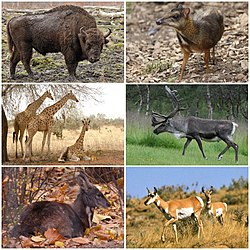| Cetruminantia Temporal range: | |
|---|---|
 | |
 | |
| Scientific classification | |
| Kingdom: | Animalia |
| Phylum: | Chordata |
| Class: | Mammalia |
| Order: | Artiodactyla |
| Clade: | Artiofabula |
| Clade: | Cetruminantia Waddell et al. 1999 |
| Subgroups | |
The Cetruminantia are a clade made up of the Cetancodontamorpha (or Whippomorpha) and their closest living relatives, the Ruminantia. [1]
Cetruminantia's placement within Artiodactyla can be represented in the following cladogram: [2] [3] [4] [5] [6]
| Artiodactyla |
| ||||||||||||||||||||||||